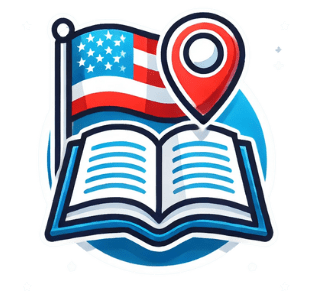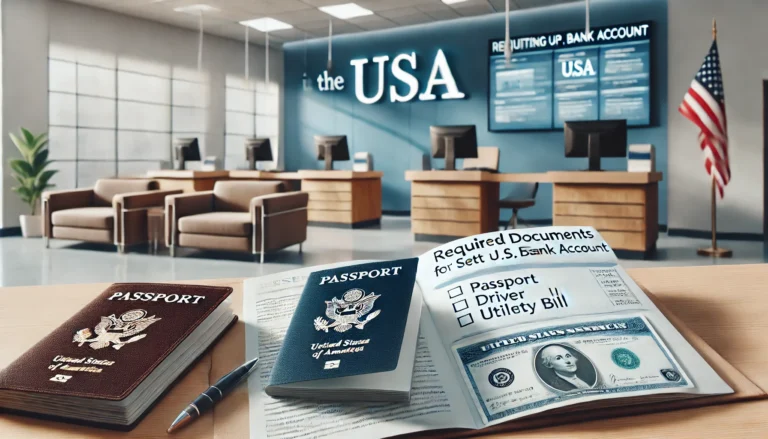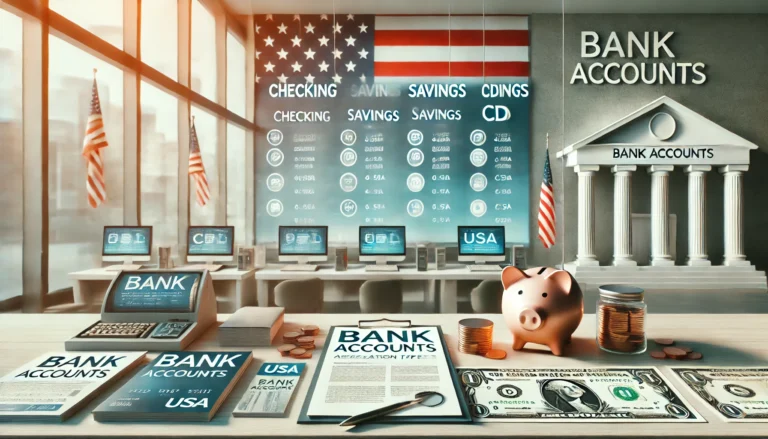Banking Basics in the USA: What You Need to Know
Whether you’re new to the U.S. or simply want a better understanding of how banking works, getting a grip on the basics is essential. The American banking system has some unique features, different types of accounts, and specific requirements that can be confusing if you’re not familiar with them. This guide aims to provide you with a clear understanding of banking in the USA, covering everything from the types of accounts available to how to protect your finances.
Table of Contents
- Introduction: Why Understanding U.S. Banking Matters
- Common Banking Terms You Should Know
- Types of Bank Accounts in the USA
- Checking Accounts
- Savings Accounts
- Money Market Accounts
- Certificates of Deposit (CDs)
- Choosing the Right Bank for Your Needs
- National vs. Regional Banks
- Online Banks vs. Traditional Banks
- The Bank Account Opening Process
- Required Documents
- Steps to Open a Bank Account
- Banking Fees and How to Avoid Them
- Monthly Maintenance Fees
- ATM Fees
- Overdraft Fees
- Understanding Checks and How to Use Them
- Writing a Check
- Depositing a Check
- Online and Mobile Banking: Managing Your Account Digitally
- Mobile Apps
- Online Transfers and Bill Pay
- Credit Cards vs. Debit Cards: What’s the Difference?
- Pros and Cons of Each
- When to Use Each Type
- Building Credit in the USA
- Credit Scores and Why They Matter
- Starting with a Secured Credit Card
- How to Protect Your Bank Account from Fraud
- Common Scams
- Tips for Online Security
- What to Do If You’re Moving or Traveling
- Managing Your Account from Abroad
- Informing Your Bank of Travel Plans
- Tips for Newcomers: Avoiding Common Banking Mistakes
- Frequently Asked Questions (FAQs)
- Conclusion: Navigating U.S. Banking with Confidence
1. Introduction: Why Understanding U.S. Banking Matters
Navigating the U.S. banking system can be a challenge, especially if you’re unfamiliar with terms and practices that are unique to this country. For newcomers, opening a bank account is one of the first steps toward settling into life in the USA. It allows you to pay bills, receive direct deposits, and start building a credit history.
Understanding U.S. banking is important not just for convenience but also for your financial security. Knowing the basics can help you avoid common pitfalls like excessive fees, overdrafts, and even fraud.
2. Common Banking Terms You Should Know
To make sense of the banking system, it’s essential to get familiar with some common terms:
- Checking Account: A basic account used for everyday transactions. It allows you to deposit money, write checks, and make withdrawals.
- Savings Account: An account designed for saving money over time, earning interest on the balance.
- Overdraft: When your account balance goes below zero because of a transaction, resulting in a fee.
- Routing Number: A unique nine-digit code used to identify the bank in transactions.
- Credit Score: A numerical representation of your creditworthiness, based on your credit history.
Knowing these terms can help you better understand the options available to you.
3. Types of Bank Accounts in the USA
Checking Accounts
A checking account is the most commonly used type of bank account in the U.S. It’s ideal for daily expenses like shopping, bill payments, and ATM withdrawals. Checking accounts typically come with a debit card and the option to write checks.
Key Features:
- Easy access to funds
- Online bill pay and mobile banking
- Possible monthly maintenance fees, which can often be waived
Savings Accounts
Savings accounts are used for storing money you don’t need immediately. They earn interest over time, although the rates can vary widely depending on the bank and account type.
Key Features:
- Higher interest rates than checking accounts
- Limited number of monthly withdrawals
- Often linked to checking accounts for easy transfers
Money Market Accounts
Money market accounts (MMAs) are similar to savings accounts but usually offer higher interest rates in exchange for higher minimum balance requirements. They may also provide check-writing privileges and debit card access.
Key Features:
- Higher interest rates compared to traditional savings accounts
- May have check-writing capabilities
- Require higher minimum balances
Certificates of Deposit (CDs)
A Certificate of Deposit is a time deposit where you agree to leave your money in the bank for a specific period, ranging from a few months to several years. In return, the bank offers a higher interest rate.
Key Features:
- Higher interest rates for longer terms
- Penalties for early withdrawal
- Fixed interest rate for the term of the CD
4. Choosing the Right Bank for Your Needs
National vs. Regional Banks
National banks, like Chase or Bank of America, have branches all over the country, making them convenient if you travel often. Regional banks operate in specific areas and may offer a more personalized experience.
Online Banks vs. Traditional Banks
Online banks generally offer higher interest rates and lower fees due to lower overhead costs. However, they lack physical branches, which can be a drawback if you prefer in-person banking.
5. The Bank Account Opening Process
Required Documents
Before you open a bank account, make sure you have the necessary documentation:
- Identification: A passport, U.S. driver’s license, or state ID.
- Proof of Address: This can be a utility bill, lease agreement, or bank statement.
- Social Security Number (SSN) or ITIN: For identification and tax purposes.
Steps to Open a Bank Account
- Choose a Bank: Decide whether you want a traditional, online, or regional bank.
- Prepare Your Documents: Make sure you have the required identification and proof of address.
- Visit a Branch or Apply Online: Most banks allow you to open an account online, but you can also visit a branch.
- Fund the Account: Some banks require a minimum deposit to open the account.
6. Banking Fees and How to Avoid Them
Monthly Maintenance Fees
Banks may charge monthly fees if your account balance falls below a certain amount. Look for accounts that offer fee waivers if you meet certain criteria, such as direct deposits.
ATM Fees
Using ATMs outside your bank’s network can result in fees. To avoid this, use ATMs within your bank’s network or choose a bank that reimburses out-of-network ATM fees.
Overdraft Fees
Overdraft fees occur when you spend more than what’s in your account. Consider setting up overdraft protection, which links your checking account to a savings account or credit line to cover shortfalls.
7. Understanding Checks and How to Use Them
Writing a Check
- Date: Write the date on the upper right corner.
- Payee: Enter the name of the person or company you’re paying.
- Amount: Fill in the amount in both numbers and words.
- Memo: Optional, but can be used to note the purpose of the check.
- Signature: Sign the check to authorize the payment.
Depositing a Check
You can deposit a check via:
- Mobile Deposit: Use your bank’s app to take a photo of the check.
- ATM Deposit: Insert the check into an ATM.
- Branch Deposit: Visit a bank branch and hand the check to a teller.
8. Online and Mobile Banking: Managing Your Account Digitally
Mobile Apps
Most banks offer mobile apps that make it easy to manage your account. You can check balances, transfer money, and even deposit checks using your smartphone.
Online Transfers and Bill Pay
Set up automatic bill payments and easily transfer money between accounts using online banking features.
9. Credit Cards vs. Debit Cards: What’s the Difference?
Understanding the differences between credit and debit cards is crucial for managing your finances in the U.S. Both types of cards have their uses, but they serve different purposes.
Pros and Cons of Each
- Credit Cards:
- Pros: Helps build credit, offers rewards like cash back or travel points, and provides fraud protection.
- Cons: Can lead to debt if not managed carefully, interest charges on unpaid balances.
- Debit Cards:
- Pros: Easy access to your money, no risk of going into debt, and good for budgeting.
- Cons: Does not build credit, fewer rewards, and limited fraud protection compared to credit cards.
When to Use Each Type
- Use a Credit Card:
- For online purchases where extra fraud protection is beneficial.
- To earn rewards on large purchases.
- When trying to build or improve your credit score.
- Use a Debit Card:
- For everyday purchases where you want to stick to a budget.
- When withdrawing cash from ATMs.
10. Building Credit in the USA
Building credit is an important aspect of financial life in the U.S., as your credit score affects your ability to get loans, rent an apartment, or even secure certain jobs.
Credit Scores and Why They Matter
Your credit score is a three-digit number that reflects your creditworthiness. It is calculated based on factors like payment history, debt levels, and the length of your credit history. Higher scores indicate lower risk to lenders.
Starting with a Secured Credit Card
A secured credit card is a good option for newcomers who are building credit for the first time. It requires a cash deposit as collateral, which acts as your credit limit. By making small purchases and paying the balance in full each month, you can gradually establish a good credit history.
11. How to Protect Your Bank Account from Fraud
Fraud is a real concern in the digital age, and taking steps to secure your bank account is essential for safeguarding your finances.
Common Scams
- Phishing: Scammers may try to trick you into revealing sensitive information through fake emails or messages that appear to be from your bank.
- Card Skimming: This involves using a device to steal card information from ATMs or payment terminals.
Tips for Online Security
- Use Strong Passwords: Choose a password that combines letters, numbers, and special characters.
- Enable Two-Factor Authentication: This adds an extra layer of security to your account.
- Avoid Public Wi-Fi: Don’t access your bank account over unsecured networks.
12. What to Do If You’re Moving or Traveling
Managing your bank account while moving or traveling can present unique challenges, but planning ahead can make things easier.
Managing Your Account from Abroad
- Set Up Online Banking: Make sure you can access your account from anywhere.
- Notify Your Bank: Inform your bank about your travel plans to avoid having your card flagged for suspicious activity.
Informing Your Bank of Travel Plans
It’s a good idea to let your bank know if you’ll be traveling, especially internationally. This can prevent your transactions from being declined due to suspected fraud.
13. Tips for Newcomers: Avoiding Common Banking Mistakes
Getting used to the U.S. banking system can take time, but these tips can help you avoid common pitfalls:
- Understand Overdraft Policies: Make sure you know what happens if your account goes below zero.
- Meet Minimum Balance Requirements: Some accounts have minimum balance requirements to avoid fees.
- Keep an Eye on Your Credit Card Balance: Avoid carrying a balance to prevent high-interest charges.
14. Frequently Asked Questions (FAQs)
- Can I open a U.S. bank account without a Social Security Number?
Yes, some banks allow accounts to be opened with an Individual Taxpayer Identification Number (ITIN) or a foreign passport. - What is the difference between a checking and savings account?
A checking account is used for daily transactions, while a savings account is intended for storing money and earning interest. - Are there any fees for closing a bank account?
Some banks may charge a fee if the account is closed shortly after opening. It’s best to check your bank’s policies. - How can I avoid ATM fees?
Use ATMs within your bank’s network or look for accounts that reimburse out-of-network ATM fees. - Can I get a credit card without a credit history?
Yes, secured credit cards are designed for individuals with little or no credit history. They help you build credit by reporting your payment activity to credit bureaus.
15. Conclusion: Navigating U.S. Banking with Confidence
Learning the basics of banking in the U.S. is a significant step toward financial stability. By understanding the different types of accounts, fees, and services available, you can make informed choices that suit your lifestyle. Remember to choose a bank that fits your needs, monitor your account regularly, and take advantage of tools like mobile banking to manage your finances more effectively.





